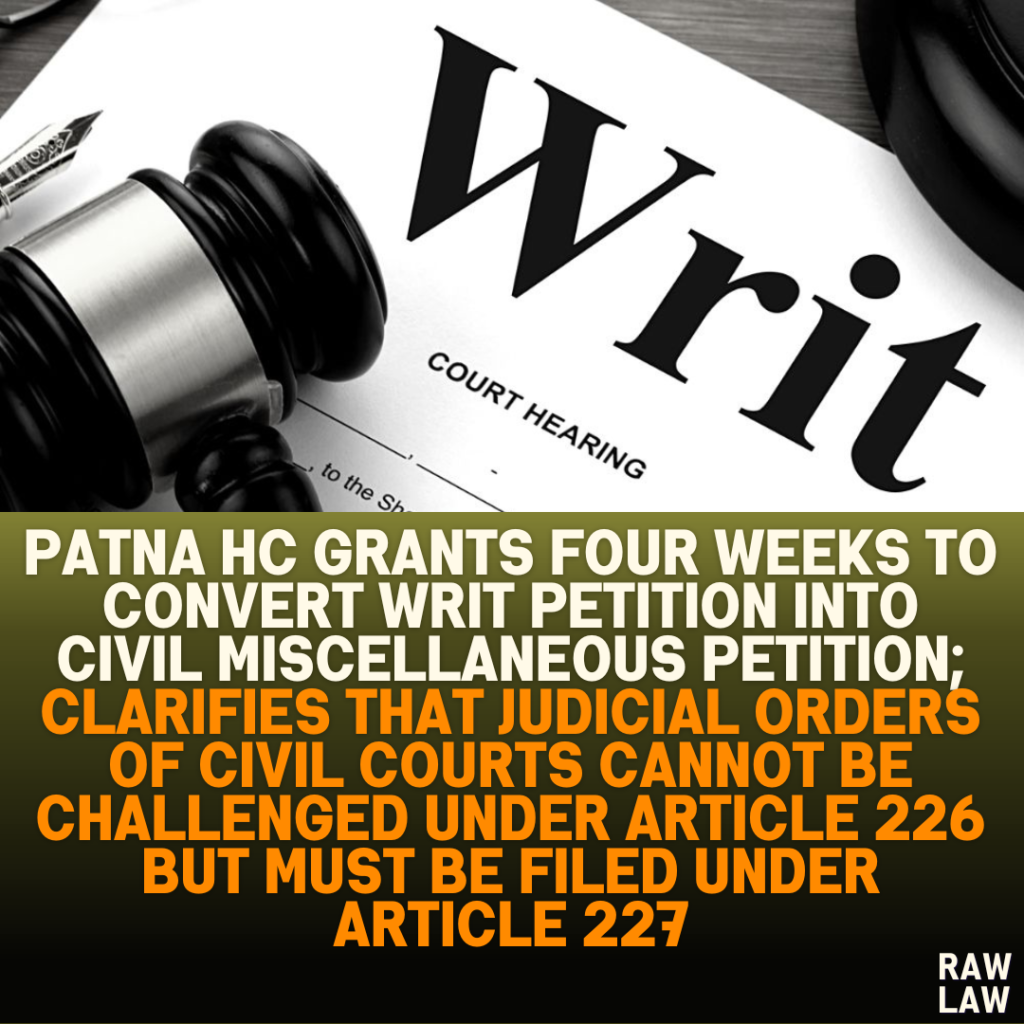Court’s Decision:
In this case, the Patna High Court granted the petitioners four weeks to convert their writ petition, originally filed under Article 226 of the Constitution, into a Civil Miscellaneous Petition under Article 227. This decision was based on the legal precedent established in the Supreme Court case Radhey Shyam v. Chhabi Nath (2015), where it was ruled that judicial orders of civil courts are not amenable to writ jurisdiction under Article 226 but could be challenged under Article 227. After the conversion, the case will be listed on priority, acknowledging that it had been pending for more than eleven years.
Facts:
The petitioners filed a writ petition in the Patna High Court challenging an order passed on 13.12.2012 by the Sub-Judge-VI, Patna, in a money suit. The petitioners had been defendants in this civil case and filed an application under Order 1 Rule 10(2) of the Civil Procedure Code (CPC) to have their names removed as defendants. However, their application was rejected by the Sub-Judge-VI, Patna.
The petitioners’ main complaint was that they were wrongly included in the list of defendants, and the civil court’s decision to keep them as parties to the suit was incorrect. The petitioners, therefore, approached the High Court under Article 226 of the Constitution, seeking to overturn this civil court order.
Issues:
Maintainability of a Writ Petition under Article 226 for Challenging Civil Court Orders:
The primary issue was whether the petitioners could invoke the writ jurisdiction of the High Court under Article 226 to challenge a civil court order.
Conversion to Civil Miscellaneous Petition under Article 227:
Given that Article 227, not Article 226, governs challenges to civil court orders, the second issue was whether the petitioners should be allowed to convert their writ petition into a Civil Miscellaneous Petition under Article 227.
Petitioner’s Arguments:
The petitioners argued that they were wrongly retained as defendants in the civil suit and that the civil court’s decision to reject their application under Order 1 Rule 10(2) of the CPC was erroneous. They invoked the High Court’s writ jurisdiction under Article 226 to set aside the civil court’s order.
Respondent’s Arguments:
The respondents countered by asserting that the writ petition filed under Article 226 was not maintainable. They relied on the precedent established in Radhey Shyam v. Chhabi Nath (2015), where the Supreme Court had clearly held that judicial orders from civil courts are not subject to writ jurisdiction under Article 226. Instead, such orders could only be challenged under Article 227, which specifically governs the superintendence of lower courts by the High Court.
Analysis of the Law:
The court’s decision was heavily influenced by the Supreme Court’s ruling in Radhey Shyam v. Chhabi Nath (2015). In that case, the Supreme Court made a clear distinction between Articles 226 and 227 of the Constitution. The court ruled that while Article 226 grants the High Courts the power to issue writs against authorities and tribunals, it does not extend to judicial orders of civil courts. For such orders, the appropriate mechanism is the supervisory jurisdiction of the High Court under Article 227.
Article 226 is generally used for cases involving the violation of fundamental rights or statutory duties, while Article 227 pertains to the High Court’s control and superintendence over lower courts and tribunals. Thus, the petitioners’ filing of a writ petition under Article 226 to challenge a civil court order was not appropriate under the law.
Precedent Analysis:
The Patna High Court referred to the landmark judgment in Radhey Shyam v. Chhabi Nath (2015), which has clarified that judicial orders of civil courts cannot be challenged through writ petitions under Article 226. Instead, they fall within the jurisdiction of Article 227.
The court also noted that, prior to Radhey Shyam, there was a legal uncertainty, and litigants were filing writ petitions against interlocutory orders of civil courts. However, the Radhey Shyam ruling has definitively settled that such petitions should not be filed under Article 226. The court further mentioned that in response to this ruling, the Patna High Court had amended its rules, requiring petitions against civil court orders to be filed under Article 227.
Court’s Reasoning:
The court explained that in light of the Supreme Court’s ruling in Radhey Shyam, the petitioners had wrongly invoked the writ jurisdiction of the High Court under Article 226. As per the law, the appropriate route for challenging civil court orders is through Article 227, not Article 226.
Given this legal distinction, the court allowed the petitioners’ request for additional time to convert their writ petition into a Civil Miscellaneous Petition under Article 227. The court further directed the registry to assist the petitioners in this conversion process and to ensure that the case is listed on priority due to its prolonged pendency.
Conclusion:
The Patna High Court granted the petitioners four weeks to convert their writ petition into a Civil Miscellaneous Petition under Article 227. The registry was instructed to cooperate with the petitioners in this conversion and prioritize the listing of the case, acknowledging that it had been pending for over eleven years.
Implications:
This judgment reinforces the procedural distinction between Articles 226 and 227. It clarifies that litigants cannot challenge judicial orders of civil courts through Article 226 but must instead use Article 227, which governs the High Court’s supervisory role over lower courts.
The ruling also underscores the impact of the Radhey Shyam judgment on the procedural rules of High Courts, ensuring that civil court orders are challenged through the correct legal channels. Additionally, the case emphasizes the importance of timely procedural compliance, as evidenced by the court’s prioritization of the case after a significant delay.




Pingback: Bombay High Court Permits Reconstruction of Lost IPAB Records in Trademark Review Petition, Emphasizes Need for Uniform Approach Amid Challenges in Retrieving Original Documents Due to IPAB Abolition - Raw Law